ALLEN Coaching
ApplyRegister for ALLEN Scholarship Test & get up to 90% Scholarship
Have you noticed how your score in a video game increases with each level you pass? Or how your savings grow month after month? Well, they don't just change randomly; they follow a certain pattern, that's what the Polynomials are all about. For example, a second-order polynomial (highest exponent 2) like
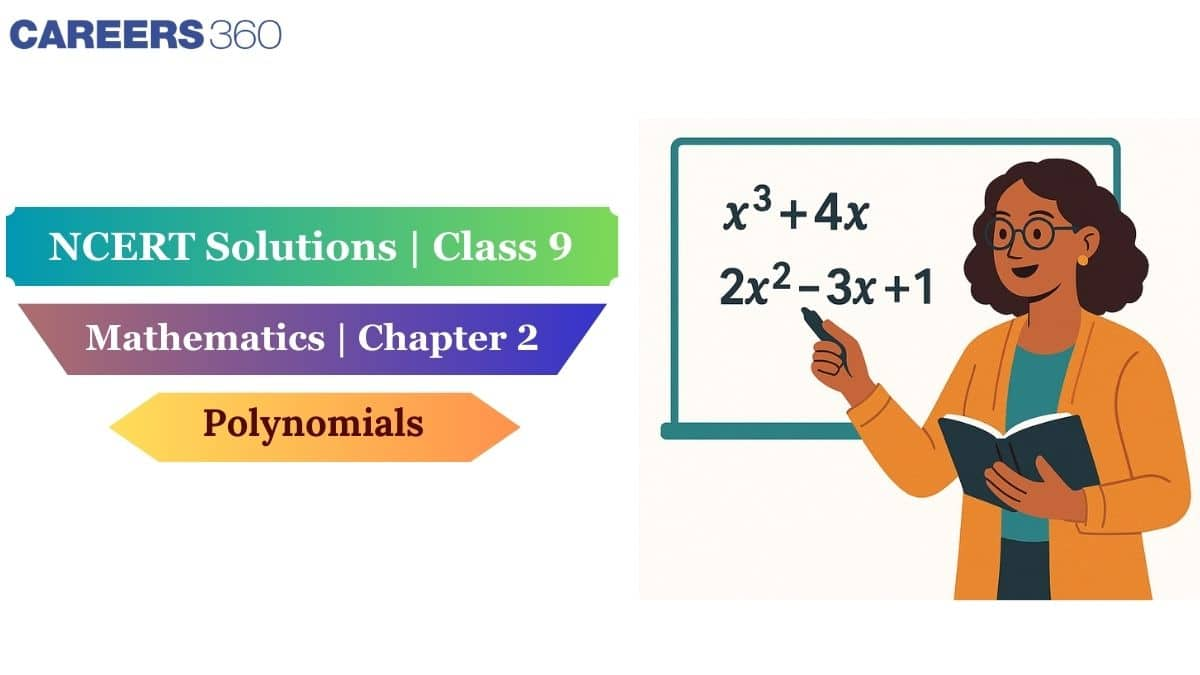
This article on NCERT solutions for class 9 Maths Chapter 2 Polynomials offers clear and step-by-step solutions for the exercise problems. Students who need the Polynomials class 9 solutions will find this article very useful. It covers all the important Class 9 Maths Chapter 2 question answers. According to the latest CBSE syllabus, these Polynomials class 9 ncert solutions are made by the Subject Matter Experts, ensuring that students can grasp the basic concepts effectively. NCERT Solutions for Class 9 and NCERT Solutions for other subjects and classes can be downloaded from our sources.
The general form of a polynomial is: p(x) = anxn + an-1xn-1 + … + a2x2 + a1x + a0
where a0, a1, a2, …., an are constants, and an ≠ 0.
Every one-variable linear polynomial will contain a unique zero, which is a real number that is a zero of the zero polynomial, and a non-zero constant polynomial that does not have any zeros.
Remainder Theorem: If p(x) has a degree greater than or equal to 1, and you divide p(x) by the linear polynomial (x - a), the remainder will be p(a).
Factor Theorem: The linear polynomial
NCERT Polynomials class 9 solutions Exercise: 2.1
Page number: 29, Total questions: 5
Question 1: (i) Is the following expression a polynomial in one variable? State reasons for your answer.
Answer:
Yes, the polynomial
Question 1: (ii) Is the following expression a polynomial in one variable? State reasons for your answer.
Answer:
YES
Given polynomial has only one variable which is y.
Question 1: (iii) Is the following expression polynomial in one variable? State reasons for your answer.
Answer:
NO
Because we can observe that the exponent of variable t in term
Therefore, this expression is not a polynomial.
Question 1: (iv) Is the following expression polynomial in one variable? State reasons for your answer.
Answer:
NO
Because we can observe that the exponent of variable y in term
Question 1: (v) Is the following expression polynomial in one variable? State reasons for your answer.
Answer:
NO
Because in the given polynomial
Question 2: (i) Write the coefficients of
Answer:
Coefficient of
Question 2: (ii) Write the coefficients of
Answer:
The coefficient of
Question 2: (iii) Write the coefficients of
Answer:
Coefficient of
Question 2: (iv) Write the coefficients of
Answer:
Coefficient of
Question 3: Give one example each of a binomial of degree 35, and of a monomial of degree 100.
Answer:
The degree of a polynomial is the highest power of the variable in the polynomial.
In binomial, there are two terms
Therefore, a binomial of degree 35 is
Eg:
In a monomial, there is only one term in it.
Therefore, a monomial of degree 100 can be written as
Question 4. (i) Write the degree the following polynomial:
Answer:
The degree of a polynomial is the highest power of the variable in the polynomial.
Therefore, the degree of the polynomial
Question 4. (ii) Write the degree the following polynomial:
Answer:
The degree of a polynomial is the highest power of the variable in the polynomial.
Therefore, the degree of polynomial
Question 4. (iii) Write the degree the following polynomial:
Answer:
The degree of a polynomial is the highest power of the variable in the polynomial.
Therefore, the degree of polynomial
Question 4. (iv) Write the degree the following polynomial: 3
Answer:
The degree of a polynomial is the highest power of the variable in the polynomial.
In this case, only a constant value 3 is there and the degree of a constant polynomial is always 0.
Question 5. (i) Classify the following as linear, quadratic and cubic polynomial:
Answer:
Linear polynomial, quadratic polynomial, and cubic polynomial has its degrees as 1, 2, and 3 respectively
Given polynomial is
Therefore, it is a quadratic polynomial.
Question 5. (ii) Classify the following as linear, quadratic and cubic polynomials:
Answer:
Linear polynomial, quadratic polynomial, and cubic polynomial have its degrees as 1, 2, and 3, respectively
Given polynomial is
Therefore, it is a cubic polynomial
Question 5 (iii) Classify the following as linear, quadratic and cubic polynomials:
Answer:
Linear polynomial, quadratic polynomial, and cubic polynomial have its degrees as 1, 2, and 3, respectively
Given polynomial is
Therefore, it is a quadratic polynomial.
Question 5. (iv) Classify the following as linear, quadratic and cubic polynomials:
Answer:
Linear polynomial, quadratic polynomial, and cubic polynomial has its degrees as 1, 2, and 3 respectively
Given polynomial is
Therefore, it is linear polynomial
Question 5. (v) Classify the following as linear, quadratic and cubic polynomial:
Answer:
Linear polynomial, quadratic polynomial, and cubic polynomial has its degrees as 1, 2, and 3 respectively
Given polynomial is
Therefore, it is a linear polynomial
Question 5. (vi) Classify the following as linear, quadratic and cubic polynomials:
Answer:
Linear polynomial, quadratic polynomial, and cubic polynomial have their degrees as 1, 2, and 3, respectively
Given polynomial is
Therefore, it is a quadratic polynomial
Question 5. (vii) Classify the following as linear, quadratic and cubic polynomials:
Answer:
Linear polynomial, quadratic polynomial, and cubic polynomial have their degrees as 1, 2, and 3, respectively
Given polynomial is
Therefore, it is a cubic polynomial.
Polynomials class 9 NCERT solutions Exercise: 2.2
Page number: 31-32, Total questions: 4
Question 1. (i) Find the value of the polynomial
Answer:
Given polynomial is
Now, at
Therefore, value of polynomial
Question 1. (ii) Find the value of the polynomial
Answer:
Given polynomial is
Now, at
Therefore, value of polynomial
Question 1. (iii) Find the value of the polynomial
Answer:
Given polynomial is
Now, at
Therefore, value of polynomial
Question 2: (i) Find p(0) , p(1) and p(2) for each of the following polynomials:
Answer:
Given polynomial is
Now,
Therefore, values of p(0) , p(1) and p(2) are 1 , 1 and 3 respectively .
Question 2: (ii) Find p(0) , p(1) and p(2) for each of the following polynomials:
Answer:
Given polynomial is
Now,
Therefore, values of p(0) , p(1) and p(2) are 2 , 4 and 4 respectively
Question 2: (iii) Find p(0), p(1) and p(2) for each of the following polynomials:
Answer:
Given polynomial is
Now,
Therefore, values of p(0) , p(1) and p(2) are 0 , 1 and 8 respectively
Question 2: (iv) Find p(0), p(1) and p(2) for each of the following polynomials:
Answer:
Given polynomial is
Now,
Therefore, values of p(0) , p(1) and p(2) are -1 , 0 and 3 respectively
Question 3. (i) Verify whether the following are zeroes of the polynomial, indicated against it.
Answer:
Given polynomial is
Now, at
Therefore, yes
Question 3. (ii) Verify whether the following are zeroes of the polynomial, indicated against it.
Answer:
Given polynomial is
Now, at
Therefore, no
Question 3. (iii) Verify whether the following are zeroes of the polynomial, indicated against it.
Answer:
Given polynomial is
Now, at x = 1 its value is
And at x = -1
Therefore, yes x = 1 , -1 are zeros of polynomial
Question 3. (iv) Verify whether the following are zeroes of the polynomial, indicated against it.
Answer:
Given polynomial is
Now, at x = 2 it's value is
And at x = -1
Therefore, yes x = 2 , -1 are zeros of polynomial
Question 3. (v) Verify whether the following are zeroes of the polynomial, indicated against it.
Answer:
Given polynomial is
Now, at x = 0 it's value is
Therefore, yes x = 0 is a zeros of polynomial
Question 3. (vi) Verify whether the following are zeroes of the polynomial, indicated against it.
Answer:
Given polynomial is
Now, at
Therefore, yes
Question 3. (vii) Verify whether the following are zeroes of the polynomial, indicated against it.
Answer:
Given polynomial is
Now, at
And at
Therefore,
whereas
Question 3. (viii) Verify whether the following are zeroes of the polynomial, indicated against it.
Answer:
Given polynomial is
Now, at
Therefore,
Question 4. (i) Find the zero of the polynomial in each of the following cases:
Answer:
Given polynomial is
Zero of a polynomial is that value of the variable at which the value of the polynomial is obtained as 0.
Now,
Therefore, x = -5 is the zero of polynomial
Question 4. (ii) Find the zero of the polynomial in each of the following cases:
Answer:
Given polynomial is
Zero of a polynomial is that value of the variable at which the value of the polynomial is obtained as 0.
Now,
Therefore, x = 5 is a zero of polynomial
Question 4. (iii) Find the zero of the polynomial in each of the following cases:
Answer:
Given polynomial is
Zero of a polynomial is that value of the variable at which the value of the polynomial is obtained as 0.
Now,
Therefore,
Question 4. (iv) Find the zero of the polynomial in each of the following cases:
Answer:
Given polynomial is
Zero of a polynomial is that value of the variable at which the value of the polynomial is obtained as 0.
Now,
Therefore,
Question 4. (v) Find the zero of the polynomial in each of the following cases:
Answer:
Given polynomial is
Zero of a polynomial is that value of the variable at which the value of the polynomial is obtained as 0.
Now,
Therefore,
Question 4. (vi) Find the zero of the polynomial in each of the following cases:
Answer:
Given polynomial is
Zero of a polynomial is that value of the variable at which the value of the polynomial is obtained as 0.
Now,
Therefore,
Question 4. (vii) Find the zero of the polynomial in each of the following cases:
Answer:
Given polynomial is
Zero of a polynomial is that value of the variable at which the value of the polynomial is obtained as 0.
Now,
Therefore,
Class 9 polynomials NCERT solutions Exercise: 2.3
Page number: 35-36, Total questions: 5
Question 1. (i) Determine which of the following polynomials has
Answer:
Zero of polynomial
If
Then,
Now,
Therefore,
Question 1. (ii) Determine which of the following polynomials has
Answer:
Zero of polynomial
If
Then,
Now,
Therefore,
Question 1. (iii) Determine which of the following polynomials has
Answer:
Zero of polynomial
If
Then,
Now,
Therefore,
Question 1. (iv) Determine which of the following polynomials has
Answer:
Zero of polynomial
If
Then,
Now,
Therefore,
Question 2: (i) Use the Factor Theorem to determine whether g(x) is a factor of p(x) in the following case:
Answer:
Zero of polynomial
If
Then,
Now,
Therefore,
Question 2: (ii) Use the Factor Theorem to determine whether g(x) is a factor of p(x) in the following case:
Answer:
Zero of polynomial
If
Then,
Now,
Therefore,
Question 2: (iii) Use the Factor Theorem to determine whether g(x) is a factor of p(x) in the following case:
Answer:
Zero of polynomial
If
Then,
Now,
Therefore,
Question 3. (i) Find the value of k , if
Answer:
Zero of polynomial
If
Then,
Now,
Therefore, the value of k is
Question 3. (ii) Find the value of k , if
Answer:
Zero of the polynomial
If
Then,
Now,
Therefore, the value of k is
Question 3. (iii) Find the value of k , if
Answer:
Zero of polynomial
If
Then,
Now,
Therefore, the value of k is
Question 3. (iv) the value of k , if
Answer:
Zero of polynomial
If
Then,
Now,
Therefore, value of k is
Question 4. (i) Factorise :
Answer:
Given polynomial is
We need to factorise the middle term into two terms such that their product is equal to
We can solve it as
Question 4. (ii) Factorise :
Answer:
Given polynomial is
We need to factorise the middle term into two terms such that their product is equal to
We can solve it as
Question 4. (iii) Factorise :
Answer:
Given polynomial is
We need to factorise the middle term into two terms such that their product is equal to
We can solve it as
Question 4. (iv) Factorise :
Answer:
Given polynomial is
We need to factorise the middle term into two terms such that their product is equal to
We can solve it as
Question 5. (i) Factorise :
Answer:
Given polynomial is
Now, by hit and trial method we observed that
By the long division method, we will get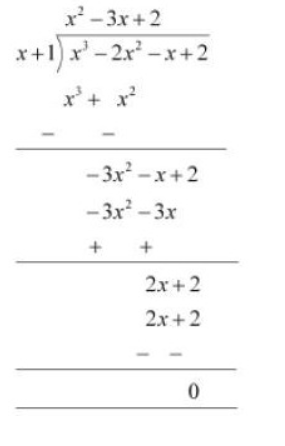
We know that Dividend = (Divisor × Quotient) + Remainder
Therefore, on factorization of
Question 5. (ii) Factorise :
Answer:
Given polynomial is
Now, by the hit-and-trial method, we observed that
By the long division method, we will get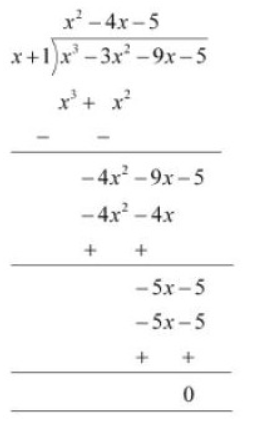
We know that Dividend = (Divisor
Therefore, on factorization of
Question 5. (iii) Factorise :
Answer:
Given polynomial is
Now, by hit and trial method we observed that
By long division method, we will get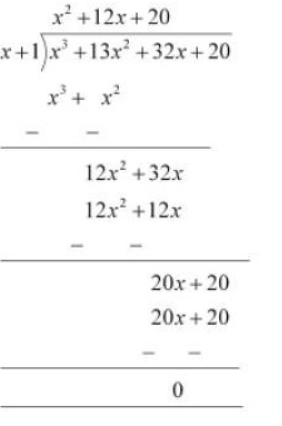
We know that Dividend = (Divisor
Therefore, on factorization of
Question 5. (iv) Factorise :
Answer:
Given polynomial is
Now, by hit and trial method we observed that
By long division method, we will get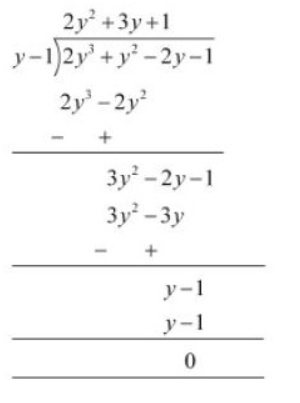
We know that Dividend = (Divisor
Therefore, on factorization of
Class 9 maths chapter 2 question answer Exercise: 2.4
Page number: 40-42, Total questions: 16
Question 1. (i) Use suitable identities to find the following product:
Answer:
We will use identity
Put
Therefore,
Question 1. (ii) Use suitable identities to find the following product:
Answer:
We will use identity
Put
Therefore,
Question 1. (iii) Use suitable identities to find the following product:
Answer:
We can write
We will use identity
Put
Therefore,
Question 1. (iv) Use suitable identities to find the following product:
Answer:
We will use identity
Put
Therefore,
Question 1. (v) Use suitable identities to find the following product:
Answer:
We can write
We will use identity
Put
Therefore,
Question 2: (i) Evaluate the following product without multiplying directly:
Answer:
We can rewrite
We will use identity
Put
Therefore, value of
Question 2: (ii) Evaluate the following product without multiplying directly:
Answer:
We can rewrite
We will use identity
Put
Therefore, value of
Question 2: (iii) Evaluate the following product without multiplying directly:
Answer:
We can rewrite
We will use identity
Put
Therefore, value of
Question 3. (i) Factorise the following using appropriate identities:
Answer:
We can rewrite
Using identity
Here,
Therefore,
Question 3. (ii) Factorise the following using appropriate identities:
Answer:
We can rewrite
Using identity
Here,
Therefore,
Question 3. (iii) Factorise the following using appropriate identities:
Answer:
We can rewrite
Using identity
Here,
Therefore,
Question 4. (i) Expand each of the following, using suitable identities:
Answer:
Given is
We will Use identity
Here,
Therefore,
Question 4. (ii) Expand each of the following, using suitable identities:
Answer:
Given is
We will Use identity
Here,
Therefore,
Question 4. (iii) Expand each of the following, using suitable identities:
Answer:
Given is
We will Use identity
Here,
Therefore,
Question 4. (iv) Expand each of the following, using suitable identities:
Answer:
Given is
We will Use identity
Here,
Therefore,
Question 4. (v) Expand each of the following, using suitable identities:
Answer:
Given is
We will Use identity
Here,
Therefore,
Question 4. (vi) Expand each of the following, using suitable identities:
Answer:
Given is
We will Use identity
Here,
Therefore,
Question 5. (i) Factorise:
Answer:
We can rewrite
We will Use identity
Here,
Therefore,
Question 5. (ii) Factorise:
Answer:
We can rewrite
We will Use identity
Here,
Therefore,
Question 6 (i) Write the following cubes in expanded form:
Answer:
Given is
We will use identity
Here,
Therefore,
Question 6. (ii) Write the following cube in expanded form:
Answer:
Given is
We will use identity
Here,
Therefore,
Question 6. (iii) Write the following cube in expanded form:
Answer:
Given is
We will use identity
Here,
Therefore,
Question 6. (iv) Write the following cube in expanded form:
Answer:
Given is
We will use identity
Here,
Therefore,
Question 7. (i) Evaluate the following using suitable identities:
Answer:
We can rewrite
We will use identity
Here,
Therefore,
Question 7. (ii) Evaluate the following using suitable identities:
Answer:
We can rewrite
We will use identity
Here,
Therefore,
Question 7. (iii) Evaluate the following using suitable identities:
Answer:
We can rewrite
We will use identity
Here,
Therefore,
Question 8. (i) Factorise the following:
Answer:
We can rewrite
We will use identity
Here,
Therefore,
Question 8. (ii) Factorise the following:
Answer:
We can rewrite
We will use identity
Here,
Therefore,
Question 8. (iii) Factorise the following:
Answer:
We can rewrite
We will use identity
Here,
Therefore,
Question 8. (iv) Factorise the following:
Answer:
We can rewrite
We will use identity
Here,
Therefore,
Question 8. (v) Factorise the following:
Answer:
We can rewrite
We will use identity
Here,
Therefore,
Question 9. (i) Verify:
Answer:
We know that
Now,
Hence proved.
Question 9. (ii) Verify:
Answer:
We know that
Now,
Hence proved.
Question 10. (i) Factorise the following:
Answer:
We know that
Now, we can write
Here,
Therefore,
Question 10. (ii) Factorise the following:
Answer:
We know that
Now, we can write
Here,
Therefore,
Question 11. Factorise:
Answer:
Given is
Now, we know that
Now, we can write
Here,
Therefore,
Question 12. Verify that
Answer:
We know that
Now, multiply and divide the R.H.S. by 2
Hence proved.
Question 13. If
Answer:
We know that
Now, It is given that
Therefore,
Hence proved.
Question 14. (i) Without actually calculating the cubes, find the value of each of the following:
Answer:
Given is
We know that
If
Here,
Therefore,
Therefore, value of
Question 14. (ii) Without actually calculating the cubes, find the value of the following:
Answer:
Given is
We know that
If
Here,
Therefore,
Therefore, value of
Question 15. (i) Give possible expressions for the length and breadth of the following rectangle, in which its area is given:
Answer:
We know that
Area of rectangle is =
It is given that area =
Now, by splitting middle term method
Therefore, two answers are possible
case (i) :- Length =
case (ii) :- Length =
Question 15. (ii) Give possible expressions for the length and breadth of the following rectangle, in which its area is given:
Answer:
We know that
Area of rectangle is =
It is given that area =
Now, by splitting the middle term method
Therefore, two answers are possible
case (i) :- Length =
case (ii) :- Length =
Question 16. (i) What are the possible expressions for the dimensions of the cuboid whose volumes is given below Volume :
Answer:
We know that
Volume of cuboid is =
It is given that volume =
Now,
Therefore,one of the possible answer is possible
Length =
Question 16: (ii) What are the possible expressions for the dimensions of the cuboid whose volumes is given below Volume :
Answer:
We know that
Volume of cuboid is =
It is given that volume =
Now,
Therefore, one of the possible answer is possible
Length =
Question: Find the value of
Answer:
Since
Therefore,
Substitute
1. Understand the definition and types of polynomials: To start effective classification of polynomials, you must first understand their definitions, along with their degrees and coefficients and linear, quadratic, and cubic types.
2. Learn how to evaluate polynomials: The substitution of values within polynomial expressions helps users evaluate their outcomes, which remains a necessary skill for tackling intricacies in problem-solving.
3. Use the Remainder Theorem: The Remainder Theorem helps determine the remainder outcome when dividing a given polynomial using a linear expression in the form x−a.
4. Master the Factor Theorem: The Factor Theorem allows users to determine linear binomials within polynomials while teaching methods to identify unknown values.
5. Perform algebraic factorisation: Students need to relate to polynomial factorisation through common algebraic patterns with strategies including the middle term separation and grouping techniques.
6. Identify and classify zeroes of polynomials: Study the methods to locate polynomial zeroes while understanding these values in connection to factors and graphical analysis.
Students can practice Class 9 Maths Chapter 2 question answers using the exercise link given below.
Here are the subject-wise links for the NCERT solutions of class 9:
Given below are some useful links for NCERT books and the NCERT syllabus for class 9:
Keep Working Hard and Happy Learning!
The NCERT class 9 maths chapter 2 includes topics such as definition of a polynomial, zeroes, coefficient, degrees, and terms of a polynomial, different types of a polynomial, remainder and factor theorems, and the factorization of polynomials. students should practice these NCERT solutions to get indepth understanding of these concepts which ultimately lead to score well in the exam.
Maths chapter 2 includes five exercises covering topics such as Polynomials in one variable, Zeros of a Polynomial, Real Numbers and their Decimal Expansions, Representing Real Numbers on the Number Line, Operations on Real Numbers, and Laws of Exponents for Real Numbers. Practicing these exercises of NCERT maths class 9 chapter 2 is crucial for achieving a better understanding of the concepts and scoring well in Mathematics. To help students gain confidence, Careers360 experts have designed these solutions to provide comprehensive explanations of the concepts covered in this chapter.
NCERT Solutions for Class 9 Maths Chapter 2 use straightforward language to explain the concepts, making it accessible even for students who struggle with Mathematics. These solutions are meticulously crafted by a team of experts at Careers360 with the objective of helping students prepare for their CBSE exams effectively.
Regular practice with NCERT Solutions for Class 9 Maths Chapter 2 can enable students to excel in their CBSE exams. These solutions are created by a team of skilled Maths experts at Careers360, and by solving all the questions and comparing their answers with the solutions, students can aim for high scores in their exams.
Here, students can get detailed NCERT solutions for Class 9 Maths which includes solutions to all the exercise of each chapters.
Admit Card Date:17 April,2025 - 17 May,2025
Admit Card Date:06 May,2025 - 20 May,2025

Register for ALLEN Scholarship Test & get up to 90% Scholarship

Get up to 90% Scholarship on Offline NEET/JEE coaching from top Institutes

This ebook serves as a valuable study guide for NEET 2025 exam.

This e-book offers NEET PYQ and serves as an indispensable NEET study material.
As per latest 2024 syllabus. Physics formulas, equations, & laws of class 11 & 12th chapters
As per latest 2024 syllabus. Chemistry formulas, equations, & laws of class 11 & 12th chapters